Fighting
is Not Complicated
...but it can be done rightly or wrongly
By
John Clements
"Everything in martial arts is about defence.
Except for defence.
Defense is about offence."
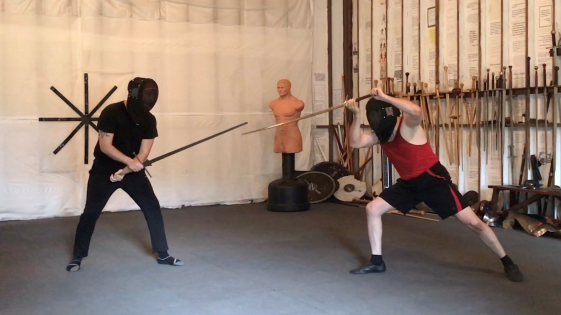 My
focus nowadays is very much on helping educate today's youth into what
I have come to call "MARCA" (Medieval and Renaissance Combat Arts).
One of my primary concerns has become aiding the next generation of practitioners
in taking things beyond the present. A large part of this consists of
revealing how once you understand its underlying core principles and actions,
they apply to all fighting. It's been a long challenge to compile a verifiable
understanding, but to me it's now fairly easy to both practice and teach.
It wasn't complicated at the time it was used in earnest and, knowing
what we've learned, it's not for us today either. My
focus nowadays is very much on helping educate today's youth into what
I have come to call "MARCA" (Medieval and Renaissance Combat Arts).
One of my primary concerns has become aiding the next generation of practitioners
in taking things beyond the present. A large part of this consists of
revealing how once you understand its underlying core principles and actions,
they apply to all fighting. It's been a long challenge to compile a verifiable
understanding, but to me it's now fairly easy to both practice and teach.
It wasn't complicated at the time it was used in earnest and, knowing
what we've learned, it's not for us today either.
A couple of years back at my Iron
Door School of Arms I had a rare occasion to play with somebody who
I have not taught or practiced with in many years. I thought the guy had
been inactive, but he had actually been training "independently"-meaning,
not in my program, not in the ARMA curriculum, not with our ethos or interpretations,
and not with our members...
As soon as I saw him bring out a pair of padded gloves with a padded
sparring jacket and take out a skinny overly-flexible sport longsword,
I knew well enough what to expect. I knew what kind of familiar idiosyncratic
habits his skill set now consisted. Needless to say, on his visit I told
him we were going to start out by just wearing sparring masks and using
stiff "feather-sword" blunts to see how he first did that way.
Otherwise, this was strictly unpadded --and obviously unarmored-- free-play
done without bulky gloves, limb guards, or thick jackets.
It went about how I expected...
But afterwards, he said to me that although he knew he "had been
out of it for a while"-which from my perspective I considered an
understatement-he couldn't understand how I had bested him, to use his
words, "so systematically and mysteriously."
Systematically? For certain. Mysteriously? ...I thought it was self-evidently
obvious.
I told him it wasn't a "mystery" and it wasn't due to a huge
difference between either our "inventory of techniques" or our
athleticism. (In fact, he was almost two decades younger than me.) I told
him it was a simple matter:
- I was using five different strikes, but he was using only two main
strikes.
- I was staying in constant motion, but he was mostly stepping slowly
or inching forward.
- I was offending and defending in a single tempo while he was parrying
and riposting with double-time actions.
- I was using eight different stances while he was relying mostly on
one or two.
- I was using a variety of grips-deliberately changing my thumb and
second hand positions or turning over my blade from one side to another.
He held his hands more or less unchanged in a double fist grip regardless
of what techniques he was doing.
- I was making no distinction between half-swording and close-in actions,
while he never went to half-sword nor deliberately closed to "gryps."
- I was constantly closing to bind and wind in delivering my hits. He
was trying to outreach me to gain the range with "stop hits"
and "timed" hits.
- I was winning "the place" by continuously "feeling"
to gain superior contact leverage blade against blade. He was essentially
trying to deliberately avoid my weapon and move away.
- I took away his offense by making him have to almost continually defend
against my blows. He was more or less just feinting and "looking
for openings."
- I was provoking, then taking and hitting with my attacks even as I
was interrupting his own with "one-two" actions. By contrast,
he was trying to evade and dodge while "spotting my strike."
- I was not concerned about his techniques or my using the "right"
Mastercut, but only about the pressure every instance our weapons crossed
or wherever our bodies or limbs were in contact.
- Lastly, I wasn't fixated on either hitting him or not getting hit
by him, but only in being audacious yet prudent. By comparison, he had
"something to prove" ...either to himself or to me.
Now, this all may sound like a lot of things going on. But it really
wasn't. And it wasn't complicated.
With my reputation as a fighter and decades of experience, it's almost
impossible for me now to get underestimated by an opponent in free-play
or to get any opponent to drop their guard against me. So, I had to learn
quite a while ago to rely on my capacity to apply a sound method. Thus,
on this occasion I simply dissected him, then unleashed. I immediately
estimated his reach, his stride, his speed, his center of gravity and
strength, then how it would all affect his capacity to leverage my weapon
or body, and me his.
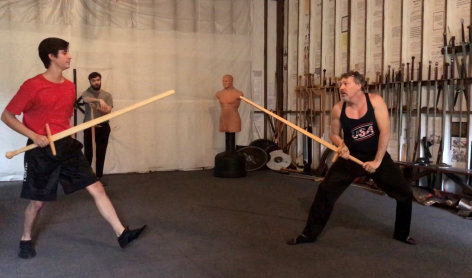 All
the chaos of fighting is massively reduced as soon as I closed to deliberately
impede and stifle up against his weapon-just as the Masters of Defence
instruct. From this there are only three or four things you essentially
can do: remain in a bind to instantly feel, repeat the action you just
used to bind, strike around to one of his other quarters, or withdraw
back away. Virtually every action I did was to bind and wind on his blade
using the resistance he supplied by either his reacting to my strikes
or his trying to strike me himself. All
the chaos of fighting is massively reduced as soon as I closed to deliberately
impede and stifle up against his weapon-just as the Masters of Defence
instruct. From this there are only three or four things you essentially
can do: remain in a bind to instantly feel, repeat the action you just
used to bind, strike around to one of his other quarters, or withdraw
back away. Virtually every action I did was to bind and wind on his blade
using the resistance he supplied by either his reacting to my strikes
or his trying to strike me himself.
Again, it's not complicated. The last thing you ever want to do is to
deliberately block as doctrine or get caught up thinking of some combination
of strikes you want to employ. Instead, you want to be concerned with
achieving the leverage advantage in the crossing, which gives you control
and freedom to act. Most importantly, nothing I've described above is
unclear from, or contradicted by, the historical source teachings.
I remember noting at the time that, as much as I could tell, his "style"
hadn't changed in years. It was more or less all the standard feint, beat,
glide, disengage, cut over, etc.-what I view as an artificial convoluted
interpretation influenced by stick fighting, sport fencing, stunt combat,
reenactment, and whatever else. If anything, his skill set was even more
retrograde given a style directed toward success at scored matches. It
certainly wasn't an understanding informed by handling original specimens,
target cutting with sharp replicas, or long-term athletic practice of
the authentic teachings in both free-play and set-play.
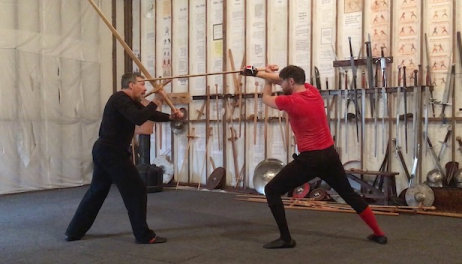 Now,
ordinarily, if this were one of my local Iron Door students or an ARMA
member I would give them a consultation. I would critique their strengths
and weaknesses, offering them advice on how to optimize their training
through proven drills and exercises. I would quote for them the relevant
instructions from the historical Masters supporting my evaluation. I would
tell them what I was doing and what they could work on to overcome someone
doing it. But, since this guy was neither my personal student nor supporting
constituent, I just used him as practice. I enjoyed the occasion to further
test my own understanding of the craft. Now,
ordinarily, if this were one of my local Iron Door students or an ARMA
member I would give them a consultation. I would critique their strengths
and weaknesses, offering them advice on how to optimize their training
through proven drills and exercises. I would quote for them the relevant
instructions from the historical Masters supporting my evaluation. I would
tell them what I was doing and what they could work on to overcome someone
doing it. But, since this guy was neither my personal student nor supporting
constituent, I just used him as practice. I enjoyed the occasion to further
test my own understanding of the craft.
So, while I did relay to him the main elements listed above and what
were, to me, the obvious distinctions between us, I made no effort whatsoever
to teach how it was that I employed them yet he didn't. It's not
my job to teach any practitioner how "not to fight." There's
an infinite number of ways-as I like to say-"to fight poorly."
The idea is to learn how to fight well according to the genuine historical
methods.
I did, however, try to point out to him that he was frequently raising
his rear heel as he moved to strike a blow. He was doing this not because
he was properly turning his foot to turn his leg to turn his hip to put
power into his strikes, nor even because he was stepping forward to pass
with his blow. Rather, he did this only because he was "stretching"
out his leg and thus raising his heel to get that "extra reach."
This common mistake had the direct effect of actually weakening his strikes
and delaying his recovery.
By standing like this, his foot often lifted completely off the
ground
after he struck. It then immediately had to go back down before
he could
take another step; otherwise he would be even more off-balance.
This kind
of "hoppy" toe-stepping footwork is common among those who
habitually
make tagging blows rather than train to cleave, slash, and shear
with
sharp blades. The latter requires much firmer footwork. This
fundamental
element of stepping should be second nature, yet it was missing
in his
repertoire. There is certainly no case that could be made to
argue that the source teachings instruct to either stand still making
deliberate static blocks or to continually play keep away by dancing
around.
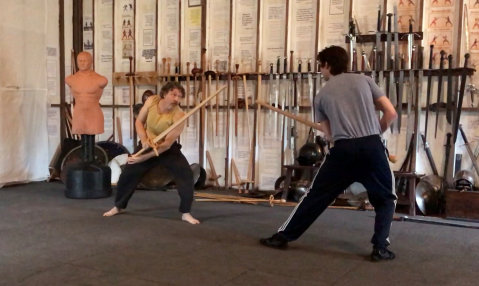 Now,
being in my 50s, I appreciate that my best sparring days are behind me.
I am not nearly as fast and agile as I was 15 or 20 years ago. Go figure.
But when it comes to wielding weaponry, prowess and mastery is not about
youthful athleticism. The decisive factors are not speed or strength or
even endurance, vital as they are, but maturity in judgment-of timing,
of distance, of leverage-and the resultant proficiency in technique acquired
from years of dedicated practice. It all fits together holistically. In
my opinion that's what distinguishes skill with hand weapons from skill
in unarmed combat. (It's why you see elderly masters of martial arts still
wielding weaponry with impressiveness but we don't really see elderly
wrestlers, boxers, or MMA fighters stepping up.) Now,
being in my 50s, I appreciate that my best sparring days are behind me.
I am not nearly as fast and agile as I was 15 or 20 years ago. Go figure.
But when it comes to wielding weaponry, prowess and mastery is not about
youthful athleticism. The decisive factors are not speed or strength or
even endurance, vital as they are, but maturity in judgment-of timing,
of distance, of leverage-and the resultant proficiency in technique acquired
from years of dedicated practice. It all fits together holistically. In
my opinion that's what distinguishes skill with hand weapons from skill
in unarmed combat. (It's why you see elderly masters of martial arts still
wielding weaponry with impressiveness but we don't really see elderly
wrestlers, boxers, or MMA fighters stepping up.)
Thus, on this occasion I played some to my visitor's inferior perception
of spatial awareness and leverage, but I did so only in the context of
everything else I've explained. And not least of all, I did everything
I'm describing here without any deliberate concentration on either "beating"
him or "avoiding being beaten." I just sparred him hard "in
the moment" with "good spirit." Whether or not you, the
reader, can apply all of the elements and concepts I've noted here yourself,
let that last bit of advice be the one thing that you take to heart in
your own study.
For novices, a great part of what I find I have to do in their first
lesson is completely replace their entire conceptualization of what historical
armed combat and "sword fighting" is all about. They invariably
have one formed out of misinformation in popular culture and whatever
combat sports or fencing styles they've been exposed to. But I've observed
that it's never one based upon the violent reality of how men and weaponry
function in the real world. Replacing common misconceptions of what historical
close combat is about with a cultivated insight into the genuine craft
is something at which I've been very successful.
I suspected what my anonymous guest had occupied himself in studying
since I last saw him is the watered-down, lowest common denominator competition
approach-a sport focus with a little Dunning-Kruger effect thrown in (...look
it up). When you add a sport mentality and a scoring motivation, it alters
the martial arts mindset so vital to fully appreciate the legitimate revival
of this Art. It also removes something I believe is critical for personal
development as a practitioner of a traditional martial discipline.
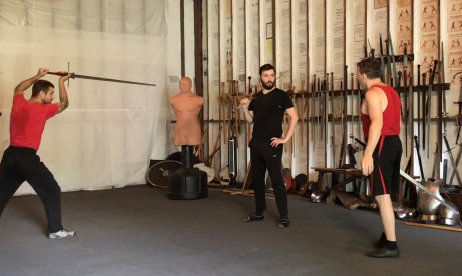 Sparring
is good, sparring is a blast; it's a huge component of training. And doing
so competitively can be a huge motivator for serious training. But mock
fighting is still just one part-a tool to develop your prowess in the
Art. It is not the end purpose of the Art. There are huge ramifications
when you make "winning laurels" the reason for your study as a martial
artist. I will add that, in my experience, all the extra padding used
in the new sporting contest version of unarmored historical fencing-of
which my visitor takes part-contributes to a lack of control and proper
binding on his part. This encourages a sloppy and imprecise manner of
striking, which then excuses acknowledgement of all manner of good hits
in non-sport practice fights. I see it regularly and have no doubt that
this was a factor in my visitor's performance that day. Sparring
is good, sparring is a blast; it's a huge component of training. And doing
so competitively can be a huge motivator for serious training. But mock
fighting is still just one part-a tool to develop your prowess in the
Art. It is not the end purpose of the Art. There are huge ramifications
when you make "winning laurels" the reason for your study as a martial
artist. I will add that, in my experience, all the extra padding used
in the new sporting contest version of unarmored historical fencing-of
which my visitor takes part-contributes to a lack of control and proper
binding on his part. This encourages a sloppy and imprecise manner of
striking, which then excuses acknowledgement of all manner of good hits
in non-sport practice fights. I see it regularly and have no doubt that
this was a factor in my visitor's performance that day.
So, after our session had ended and the afternoon's exertion taken its
toll, I felt generous enough to leave my visitor with something more profound
to ponder. I told him: "...you know, if you're not defending yourself
by keeping the opponent from being free to attack you, then you're just
not applying the Art." After all, the fundamental essence
of any true self-defense method is to be able to avoid injury. There is
no better way to do this than to learn to hit and not be hit.
Of course, I didn't bother to explain that the best means to achieve
this is by aggressively hitting the opponent yourself-or at the least,
by keeping them too busy guarding against you to do otherwise. This so
unambiguously expressed by so many of our source teachings that I shouldn't
have to even mention it. Fighting is not complicated. Everything is
about defence. Except for defence. Defence is about offence.
"...And ever your foote, your hand, your eye, and your heart to
accord"
- mid-15th century English fencing poem
"your hand, your foot, and your body, all of which
parts must go together and unless you can stir and move all these together,
you shall never be able to perform any great matter but with great danger"
- Vincentio Saviolo, 1595
11-2018
|

